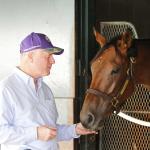
Cugino Gets Slight Edge in Wide-Open Ft. Lauderdale Stakes

With the Kentucky Derby Presented by Woodford Reserve and the Preakness Stakes in the books, it is time to turn our attention to the Belmont Stakes Presented by NYRA Bets on June 5 at Belmont Park. Below are some key racing terms to know before the Belmont Stakes, and be sure to check out the Learn page on America’s Best Racing for additional racing terms, educational information, and betting tips.

Triple Crown: Thirteen horses in racing history have captured the Triple Crown, which refers to winning the Kentucky Derby, Preakness Stakes, and Belmont.
Chalk: A heavy favorite for a race. Calling a favorite the chalk dates back to when bookies used chalkboards to update odds and the odds of the favorite had to be continually updated as money came in on that horse.
Blaze: A generic term describing a large, white vertical marking on a horse’s face.
Graded stakes: These are the highest-level races in horse racing. On a good day at the track, you may witness one or two graded stakes but on Belmont Stakes day there are nine graded stakes scheduled. In addition to the Belmont Stakes, other graded stakes on the card include: Longines Just a Game Stakes, Jackpocket Jaipur Stakes, Acorn Stakes, Ogden Phipps Stakes, Woody Stephens Stakes, The Resorts World Casino Manhattan Stakes, Hill ‘N’ Dale Metropolitan Handicap, and the Brooklyn Invitational Stakes Presented by Northwell Health.
Big Sandy: The nickname of Belmont Park, referring to the massive size of the track that has traditionally been known for its tiring, sandy surface.
Sophomores: Three-year-old horses. Called sophomores because age three is the second year of racing eligibility. All of the horses competing in the Belmont Stakes will be “sophomores.”
NYRA: The New York Racing Association (NYRA) is the corporation that operates New York’s three major racetracks — Aqueduct, Saratoga Race Course, and Belmont Park.
Wire to Wire: This refers to when a horse wins a race by being on the lead from start to finish, much like American Pharoah did when winning the Belmont Stakes to capture the Triple Crown in 2015.
Belmont Jewel: This is the official drink of the Belmont Stakes. It consists of Woodford Reserve bourbon, lemonade, and pomegranate juice topped off with orange zest.
Paddock: This is the area where the horses get saddled before the race and where the jockeys climb aboard before walking through the “tunnel” (in the case of Belmont) to get to the track.
LIRR: The Long Island Rail Road (LIRR) is the most commonly used means of transportation to get to Belmont Park in Elmont, NY.
Grand Slam: This is a bet type that is unique to New York tracks. The Grand Slam requires the person making the wager to pick a horse who finishes in the first three positions in three consecutive races, and then select the winner of the fourth race in the sequence.

Test of the Champion: The Belmont Stakes is often referred to as the “Test of the Champion” because it demands runners pass the grueling test of a mile-and-a-half distance on “Big Sandy.” Not only can the surface be tiring, the distance of the race is a quarter of a mile longer than the Kentucky Derby and will, for most runners in the race, represent the longest race they’ll ever run.
Furlong: An eighth of a mile. The Belmont Stakes is a 12-furlong race, which is equivalent to 1 ½ miles.
Length: A measurement approximating the length of a horse, used to denote distance between horses in a race. For example, “Secretariat won the Belmont Stakes by 31 lengths.”
Handicapping: This is the study of factors in the past performances of racehorses used to determine the relative qualities and abilities of horses in a race.
Speed Figure: A metric that rates a horse’s performance in a race, which is determined by a combination of the horse’s performance and the level of competition he/she competed against.